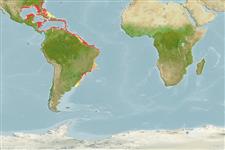Common names from other countries
Teleostei (teleosts) >
Carangaria/misc (Various families in series Carangaria) >
Sphyraenidae (Barracudas)
Etymology: Sphyraena: Greek, sphyraina, -es = the name of a fish (Ref. 45335).
More on author: Poey.
Environment: milieu / climate zone / depth range / distribution range
Ecology
Marine; reef-associated; depth range 1 - 65 m (Ref. 9626). Tropical; 33°N - 35°S, 97°W - 34°W
Western Atlantic: Bermuda, Florida (USA), and the Bahamas to Uruguay.
Size / Weight / Age
Maturity: Lm ? range ? - ? cm
Max length : 61.0 cm FL male/unsexed; (Ref. 40637); common length : 36.0 cm TL male/unsexed; (Ref. 3819); max. published weight: 1.1 kg (Ref. 40637)
Inhabits coastal waters. Found in rocky or coral reefs (Ref. 9710). More abundant over muddy bottoms. Juveniles are encountered in seagrass beds (Ref. 9626). Often occurs in large schools, sometimes near the surface (Ref. 9626). Marketed fresh and frozen.
Life cycle and mating behavior
Maturity | Reproduction | Spawning | Eggs | Fecundity | Larvae
Robins, C.R. and G.C. Ray, 1986. A field guide to Atlantic coast fishes of North America. Houghton Mifflin Company, Boston, U.S.A. 354 p. (Ref. 7251)
IUCN Red List Status (Ref. 130435)
CITES (Ref. 128078)
Not Evaluated
Threat to humans
Reports of ciguatera poisoning (Ref. 30911)
Human uses
Fisheries: minor commercial; gamefish: yes
More information
ReferencesAquacultureAquaculture profileStrainsGeneticsElectrophoresesHeritabilityDiseasesProcessingMass conversion
Tools
Special reports
Download XML
Internet sources
Estimates based on models
Preferred temperature (Ref.
115969): 22.7 - 28, mean 26.1 (based on 402 cells).
Phylogenetic diversity index (Ref.
82804): PD
50 = 0.5000 [Uniqueness, from 0.5 = low to 2.0 = high].
Bayesian length-weight: a=0.00617 (0.00308 - 0.01235), b=2.92 (2.75 - 3.09), in cm Total Length, based on LWR estimates for this species & Genus-body shape (Ref.
93245).
Trophic level (Ref.
69278): 4.2 ±0.3 se; based on diet studies.
Resilience (Ref.
120179): Medium, minimum population doubling time 1.4 - 4.4 years (Preliminary K or Fecundity.).
Fishing Vulnerability (Ref.
59153): Moderate to high vulnerability (47 of 100).
